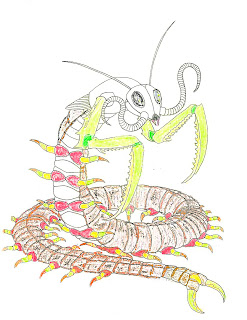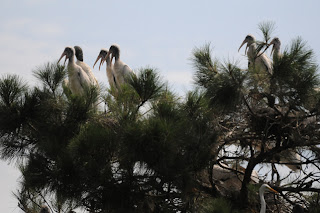The last two weeks of
summer camp at the Audubon Center at
Francis Beidler Forest have occupied most of our time and made it difficult to post a blog entry. Therefore, today's entry is a hodgepodge covering that time period and is in no particular order!
 |
| Camper-made butterfly houses - Mark Musselman |
 |
| St. John's Wort species blooming - Mark Musselman |
 |
| Dwarf Palmetto blooming - Mark Musselman |
 |
| Eastern Cottonmouth (small) on palmetto frond - Mark Musselman |
 |
| Red-shouldered Hawk calling - Mark Musselman |
 |
| Nine-banded Armadillo family at den - Mark Musselman |
 |
| Nine-banded Armadillo family at den - Mark Musselman |
Nine-banded Armadillos have been in the swamp for a few years, but have only recently taken up residence near the boardwalk just before #2. Visitors reported seeing them throughout the weekend and summer campers got a good look at these four outside their den.
 |
| Fledgling Prothonotary Warbler - Mark Musselman |
 |
| Male Prothonotary Warbler A287 with prey - Mark Musselman |
Here dad appears to have a cockroach. In the following series, he appears to have captured a large spider. All of this parental activity took place within ten feet of the boardwalk and two dozen excited summer campers.
 |
| Male Prothonotary Warbler A287 feeding fledgling - Mark Musselman |
 |
| Male Prothonotary Warbler A287 feeding fledgling - Mark Musselman |
 |
| Male Prothonotary Warbler A287 feeding fledgling - Mark Musselman |
 |
| Male Prothonotary Warbler A287 feeding fledgling - Mark Musselman |
 |
| Male Prothonotary Warbler A287 feeding fledgling - Mark Musselman |
 |
| Male Prothonotary Warbler A287 feeding fledgling - Mark Musselman |
 |
| Male Prothonotary Warbler A287 feeding fledgling - Mark Musselman |
 |
| Male Prothonotary Warbler A287 feeding fledgling - Mark Musselman |
 |
| Male Prothonotary Warbler A287 feeding fledgling - Mark Musselman |
 |
| Male Prothonotary Warbler A287 feeding fledgling - Mark Musselman |
 |
| Male Great Blue Skimmer - Mark Musselman |
The theme of summer camp was insects and campers saw plenty! One morning was spent with nets out on the power line right-of-way catching and releasing butterflies, moths, and dragonflies.
 |
| Greenish Rat Snake climbing - Mark Musselman |
A sharp-eyed camper spotted this large rat snake moving under the boardwalk. All the excitement from the campers prompted the snake to climb a nearby vine for a safer, eye-to-eye perch.
 |
| White-tailed Deer fawn - Mark Musselman |
 |
| White-tailed Deer fawn nursing - Mark Musselman |
 |
| White-tailed Deer doe & fawns - Mark Musselman |
We saw this doe and her twins repeatedly during the two weeks of camp. We have posted a short video of several encounters, including one where the unseen doe eventually appears from under the boardwalk. You can find the video on our
webpage.
 |
| Young Yellow-bellied Slider - Mark Musselman |
 |
| Carolina Wren feeding cowbird - Mark Musselman |
These last two birds shots are from Summerville, but we heard Brown-headed Cowbirds along the boardwalk. The two Carolina Wren parents were busy feeding the one Brown-headed Cowbird chick, while no wren chicks were present. Not all species are fooled by the cowbird's parasitism, but these two wrens, half the size of the chick they were feeding, certainly were duped.
 |
| Brown-headed Cowbird chick being fed by Carolina Wrens - Mark Musselman |
 |
| Tropical Storm Debby |
Finally, Tropical Storm Debby may be bringing more water to the Four Holes Swamp. Currently, the storm models cannot agree, with some taking the storm west to Texas, while other models have it tracking across Florida. Based on its size, any motion to the northeast will deliver rain to the swamp, which is only now starting to show low water levels after Tropical Storm Beryl and the following rain. Obviously, some people in low areas will not welcome drenching rains of a tropical storm, but it does not bother a swamp and a swamp always looks better when it has plenty of water!
































































